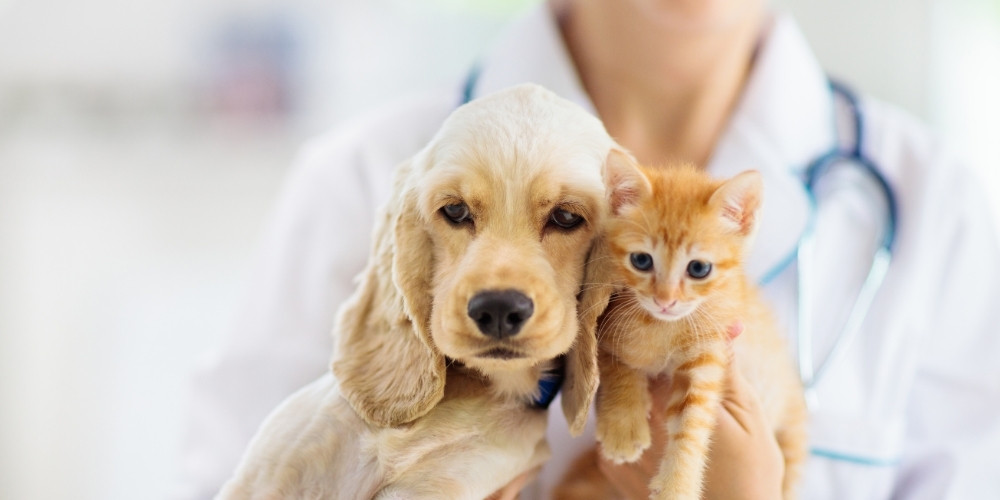สัตว์เลี้ยงของคุณเป็นโรคเบาหวานหรือไม่? เรียนรู้ว่าเครื่องวัดระดับน้ำตาลในเลือดสำหรับสัตว์เลี้ยงสามารถช่วยคุณได้อย่างไร

สัตว์เลี้ยงแสนรักของคุณดื่มน้ำมากกว่าปกติ น้ำหนักลดลง เบื่ออาหาร หรือดูซึมเซาหรือไม่? อาการเหล่านี้อาจเกี่ยวข้องกับระดับน้ำตาลในเลือด เจ้าของสัตว์เลี้ยงหลายคนกังวลว่าการพาสัตว์เลี้ยงไปตรวจที่คลินิกอาจทำให้เครียด โชคดีที่มีวิธีแก้ปัญหาที่ง่ายกว่านั้น นั่นคือการใช้เครื่องวัดระดับน้ำตาลในเลือดสำหรับสัตว์เลี้ยงที่บ้าน อุปกรณ์เหล่านี้ได้รับการออกแบบมาโดยเฉพาะสำหรับสัตว์เลี้ยง ใช้งานง่าย และให้ค่าที่แม่นยำ ช่วยให้คุณสามารถตรวจสอบระดับน้ำตาลในเลือดได้ทุกเมื่อ ในบทความนี้ เราจะสำรวจวิธีการจัดการระดับน้ำตาลในเลือดของสัตว์เลี้ยง แนะนำเครื่องวัดระดับน้ำตาลในเลือดสำหรับสัตว์เลี้ยงที่เชื่อถือได้ อธิบายวิธีการใช้งาน และตอบคำถามทั่วไปเพื่อช่วยให้คุณเริ่มต้นได้อย่างมั่นใจ
เหตุใดจึงควรตรวจสอบระดับน้ำตาลในเลือดของสัตว์เลี้ยง?
ระดับน้ำตาลในเลือดที่สูงอย่างต่อเนื่องในสัตว์เลี้ยงอาจนำไปสู่ภาวะแทรกซ้อน เช่น ต้อกระจก โรคไต ความเสียหายของเส้นประสาท และความเสี่ยงต่อการติดเชื้อที่เพิ่มขึ้น หากปล่อยให้โรคเบาหวานไม่ได้รับการรักษา อาจลุกลามไปสู่ภาวะคีโตอะซิโดซิส ซึ่งมีลักษณะอาการ เช่น อาเจียน อ่อนแรง ขาดน้ำ และในกรณีที่รุนแรงอาจเป็นอันตรายถึงชีวิตได้ ในทางกลับกัน ภาวะน้ำตาลในเลือดต่ำก็ไม่ควรถูกมองข้ามเช่นกัน เพราะอาจทำให้เกิดอาการสั่น เดินเซ สับสน ชัก โคม่า หรือแม้กระทั่งช็อกได้ ลูกสุนัข สุนัขสูงอายุ และสัตว์เลี้ยงที่กำลังรับการรักษาด้วยอินซูลินมีความเสี่ยงเป็นพิเศษ แม้ว่าสถานการณ์เหล่านี้อาจฟังดูน่าตกใจ แต่การตรวจวัดระดับน้ำตาลในเลือดอย่างสม่ำเสมอจะช่วยให้ตรวจพบความผิดปกติได้ตั้งแต่เนิ่นๆ ทำให้สามารถปรับเปลี่ยนอาหารหรือวางแผนการรักษาได้ทันท่วงที ซึ่งจะช่วยลดความเสี่ยงของภาวะแทรกซ้อนได้อย่างมาก
ช่วงระดับน้ำตาลในเลือดที่เหมาะสมสำหรับสัตว์เลี้ยง
ระดับน้ำตาลในเลือดที่เหมาะสมสำหรับแมว
ระดับน้ำตาลในเลือดปกติของแมวอยู่ที่ประมาณ 74–159 มิลลิกรัม/เดซิลิตร ระดับที่ต่ำกว่า 74 มิลลิกรัม/เดซิลิตร อาจส่งผลต่อการทำงานของระบบประสาทและกล้ามเนื้อ และอาจนำไปสู่ภาวะโคม่าได้ หากระดับน้ำตาลในเลือดสูงเกิน 159 มิลลิกรัม/เดซิลิตร จำเป็นต้องเฝ้าติดตามอย่างใกล้ชิด ค่าที่สูงกว่า 250 มิลลิกรัม/เดซิลิตร อาจบ่งชี้ถึงโรคเบาหวาน และควรปรึกษาสัตวแพทย์
ระดับน้ำตาลในเลือดที่เหมาะสมสำหรับสุนัข
สำหรับสุนัข ระดับน้ำตาลในเลือดปกติจะอยู่ในช่วงประมาณ 74–143 มิลลิกรัม/เดซิลิตร ระดับที่ต่ำกว่า 74 มิลลิกรัม/เดซิลิตร อาจทำให้สุนัขอ่อนแรง ซึม หรือแม้กระทั่งชักได้ ระดับน้ำตาลในเลือดที่สูงกว่า 143 มิลลิกรัม/เดซิลิตร อาจเป็นสัญญาณเริ่มต้นของโรคเบาหวาน และหากสูงเกิน 200 มิลลิกรัม/เดซิลิตร ควรปรึกษาสัตวแพทย์โดยทันที
ค่าระดับน้ำตาลในเลือดสำหรับแมวและสุนัข
| ค่าระดับน้ำตาลในเลือดของแมว | ค่าระดับน้ำตาลในเลือดของสุนัข | |
|---|---|---|
| ต่ำเกินไป | <74 มก./ดล. | <74 มก./ดล. |
| ปกติ | 74–159 มก./ดล. | 74–143 มก./ดล. |
| ผิดปกติ | 159–250 มก./ดล. | 143–200 มก./ดล. |
| โรคเบาหวาน | >250 มก./ดล. | >200 มก./ดล. |
ค่าเหล่านี้ใช้สำหรับการอ้างอิงเท่านั้น การวินิจฉัยโรคเบาหวานที่แน่ชัดควรทำโดยสัตวแพทย์
วิธีการวัดระดับน้ำตาลในเลือดของสัตว์เลี้ยง
การตรวจวัดระดับน้ำตาลในเลือดเป็นประจำมีความสำคัญอย่างยิ่งต่อการรักษาสุขภาพของสัตว์เลี้ยง โดยเฉพาะแมวและสุนัขที่เป็นโรคเบาหวาน ในที่นี้ เราจะแนะนำสองวิธีในการตรวจวัดระดับน้ำตาลในเลือด เพื่อช่วยให้เจ้าของสัตว์เลี้ยงเข้าใจวิธีการตรวจวัดที่รวดเร็วและมีประสิทธิภาพ
การตรวจวินิจฉัยโรคในคลินิกสัตวแพทย์
คลินิกสัตวแพทย์มีอุปกรณ์ระดับมืออาชีพที่ให้ข้อมูลระดับน้ำตาลในเลือดที่แม่นยำ ช่วยในการวินิจฉัยและปรับการรักษา อย่างไรก็ตาม สัตว์เลี้ยงอาจวิตกกังวลในสภาพแวดล้อมที่ไม่คุ้นเคย ทำให้ระดับอะดรีนาลินเพิ่มสูงขึ้นและระดับน้ำตาลในเลือดพุ่งสูงขึ้นชั่วคราว ซึ่งอาจส่งผลต่อความแม่นยำในการวัด ดังนั้น สัตวแพทย์จึงมักพิจารณาผลการทดสอบหลายอย่างควบคู่ไปกับอาการทางคลินิกเพื่อประเมินสถานะระดับน้ำตาลในเลือด
การทดสอบที่บ้าน
การตรวจระดับน้ำตาลในเลือดที่บ้านช่วยให้สัตว์เลี้ยงของคุณอยู่ในสภาพแวดล้อมที่คุ้นเคย ช่วยให้พวกมันผ่อนคลายและลดความผันผวนของระดับน้ำตาลในเลือดที่เกิดจากความเครียด การใช้เครื่องวัดระดับน้ำตาลในเลือดสำหรับสัตว์เลี้ยงเพื่อตรวจเป็นประจำที่บ้าน เจ้าของสามารถติดตามการเปลี่ยนแปลงของระดับน้ำตาลในเลือดและรักษาสุขภาพของสัตว์เลี้ยงได้อย่างมีประสิทธิภาพ
วิธีใช้เครื่องวัดระดับน้ำตาลในเลือดสำหรับสัตว์เลี้ยง
เครื่องวัดระดับน้ำตาลในเลือดสำหรับสัตว์เลี้ยงช่วยให้คุณวัดระดับน้ำตาลในเลือดของสัตว์เลี้ยงได้อย่างรวดเร็ว ทำให้คุณสามารถตรวจสอบสุขภาพของสัตว์เลี้ยงได้ตลอดเวลา การเก็บตัวอย่างเลือดและการบันทึกข้อมูลอย่างถูกต้องเป็นสิ่งสำคัญสำหรับการจัดการโรคเบาหวานหรือความผิดปกติของระดับน้ำตาลในเลือดอย่างแม่นยำ ขั้นตอนการใช้เครื่องวัดระดับน้ำตาลในเลือดสำหรับสัตว์เลี้ยงมีดังต่อไปนี้ เพื่อช่วยให้เจ้าของเริ่มต้นใช้งานได้ง่ายและมั่นใจได้ว่าการวัดมีความแม่นยำ เพื่อรักษาสุขภาพที่ดีของสัตว์เลี้ยง
การเตรียมตัว: ก่อนทำการทดสอบ ให้ล้างมือให้สะอาดเพื่อป้องกันการปนเปื้อนของแบคทีเรีย เตรียมสำลีชุบแอลกอฮอล์ เข็มเจาะเลือด และแถบทดสอบให้พร้อม ทำให้สัตว์เลี้ยงของคุณสงบลงเพื่อลดความไม่สบายและความเครียดระหว่างการวัด
การเก็บตัวอย่างเลือด: บริเวณที่นิยมเก็บตัวอย่างเลือดจากสัตว์เลี้ยง ได้แก่ เส้นเลือดที่ขอบใบหู ริมฝีปากด้านใน หรือฝ่าเท้า นวดบริเวณเหล่านั้นเบา ๆ เพื่อกระตุ้นการไหลเวียนของเลือด จากนั้นใช้เข็มเจาะผิวหนังเพื่อเก็บตัวอย่างเลือดเล็กน้อย หากมองเห็นเส้นเลือดได้ไม่ชัดเจน สามารถใช้ไฟฉายช่วยในการระบุตำแหน่งได้
การวัดและการบันทึก: ใช้การ์ดรหัสที่เหมาะสมสำหรับสัตว์เลี้ยงของคุณ (สุนัขหรือแมว) เพื่อปรับเทียบเครื่องวัด ตรวจสอบให้แน่ใจว่ารหัสบนหน้าจอตรงกับบรรจุภัณฑ์ของแถบทดสอบ ยืนยันว่าเครื่องวัดแสดงสัญลักษณ์หยดเลือด ซึ่งแสดงว่าพร้อมสำหรับการทดสอบแล้ว แตะปลายแถบทดสอบลงบนหยดเลือด ปล่อยให้แถบทดสอบดูดซับตัวอย่างและเริ่มการวัด หลังจากทดสอบแล้ว ให้บันทึกผลลัพธ์และเวลาเพื่อติดตามแนวโน้มระดับน้ำตาลในเลือดและปรึกษากับสัตวแพทย์ของคุณเป็นประจำ
คำถามที่พบบ่อยเกี่ยวกับการใช้เครื่องวัดระดับน้ำตาลในเลือดสำหรับสัตว์เลี้ยง
เมื่อเริ่มใช้เครื่องวัดระดับน้ำตาลในเลือดสำหรับสัตว์เลี้ยงครั้งแรก คุณอาจพบกับความท้าทายบ้าง แต่หากเรียนรู้เทคนิคและวิธีการตอบสนองที่ถูกต้อง คุณจะสามารถปรับปรุงความแม่นยำในการวัดและทำให้การตรวจวัดระดับน้ำตาลในเลือดคงที่มากขึ้น ด้านล่างนี้ เราได้รวบรวมคำถามที่พบบ่อยหลายข้อเพื่อช่วยให้เจ้าของทำการทดสอบได้อย่างราบรื่นและลดความไม่สบายตัวของสัตว์เลี้ยงให้น้อยที่สุด
จะทำอย่างไรถ้าสัตว์เลี้ยงของฉันไม่ยอมให้เจาะเลือด?
หากสัตว์เลี้ยงของคุณต่อต้านการเจาะเลือด โปรดใจเย็นเพื่อหลีกเลี่ยงการเพิ่มความวิตกกังวล ก่อนการเจาะเลือด ให้ลูบและพูดกับพวกมันเบาๆ เพื่อช่วยให้พวกมันผ่อนคลาย สร้างสภาพแวดล้อมที่เงียบสงบและสะดวกสบายเพื่อลดการรบกวนจากภายนอก หากยังคงต่อต้าน ให้พิจารณาเจาะเลือดเป็นระยะ และให้รางวัลและความสะดวกสบายระหว่างกระบวนการเพื่อสร้างความไว้วางใจ ซึ่งจะทำให้การวัดครั้งต่อไปง่ายขึ้น
จะทำอย่างไรหากมีปริมาณเลือดไม่เพียงพอในระหว่างการเก็บตัวอย่าง?
นวดเบาๆ บริเวณที่เจาะเลือดเพื่อกระตุ้นการไหลเวียนของเลือด จากนั้นพยายามเก็บตัวอย่างเลือดให้ได้ปริมาณที่เพียงพอ หากยังไม่สามารถเก็บเลือดได้เพียงพอ ให้ใช้แถบตรวจใหม่และลองอีกครั้ง หากยังคงเก็บเลือดได้ยาก ให้พิจารณาเปลี่ยนตำแหน่งที่เจาะเลือดหรือใช้เข็มเจาะเลือดที่เล็กกว่าเพื่อลดความไม่สบายและให้ได้เลือดเพียงพอ ใจเย็นๆ และให้สัตว์เลี้ยงของคุณพักผ่อนเพื่อหลีกเลี่ยงแรงกดดันมากเกินไป
สถานที่ใดเหมาะสมที่สุดสำหรับการเก็บตัวอย่างเลือด?
โดยทั่วไปแล้ว เส้นเลือดบริเวณขอบใบหูเป็นตำแหน่งที่ดีที่สุดสำหรับการเก็บตัวอย่างเลือด เนื่องจากเส้นเลือดมองเห็นได้ชัดเจนกว่า และกระบวนการค่อนข้างตรงไปตรงมา บริเวณนี้ช่วยให้ระบุตำแหน่งได้ง่ายและมีปริมาณเลือดไหลเวียนเพียงพอ นอกจากนี้ยังทำให้สัตว์เลี้ยงที่ไวต่อความรู้สึกรู้สึกสบายกว่า และช่วยให้การวัดระดับน้ำตาลในเลือดเป็นไปอย่างราบรื่น สำหรับผู้ใช้ครั้งแรก วิธีนี้โดยทั่วไปแล้วจะง่ายต่อการเรียนรู้
ระบบตรวจวัดระดับน้ำตาลในเลือด SweePaw จาก SANcheck: เพื่อนคู่ใจด้านสุขภาพที่ดีที่สุดสำหรับสัตว์เลี้ยงของคุณ
หากคุณกำลังมองหาเครื่องวัดระดับน้ำตาลในเลือดสำหรับสัตว์เลี้ยงที่เชื่อถือได้และแม่นยำ รุ่นของ GL Biotech ออกแบบมาโดยเฉพาะสำหรับสัตว์เลี้ยง ให้วิธีการตรวจวัดระดับน้ำตาลในเลือดที่ง่าย รวดเร็ว และแม่นยำ โดยใช้เทคโนโลยีทางเคมีไฟฟ้าแบบเดียวกับอุปกรณ์ทางการแพทย์ และมีระบบดีดแถบตรวจ ทำให้ได้ผลลัพธ์ภายใน 5 วินาที การทดสอบใช้เลือดเพียงเล็กน้อย ลดความไม่สบายตัวของสัตว์เลี้ยง และช่วยให้เจ้าของสามารถตรวจสอบระดับน้ำตาลในเลือดได้อย่างสะดวกสบายและไม่เครียดได้ทุกเวลา
〈คำแนะนำ: เครื่องตรวจวัดระดับน้ำตาลในเลือด SANcheck SweePaw 〉
บทสรุป
เครื่องวัดระดับน้ำตาลในเลือดสำหรับสัตว์เลี้ยงช่วยให้เจ้าของสามารถตรวจสอบระดับน้ำตาลในเลือดของสัตว์เลี้ยงได้ทุกเมื่อ ช่วยรักษาสุขภาพและป้องกันการลุกลามของโรค เราขอแนะนำเป็นอย่างยิ่งคือ ระบบตรวจสอบระดับน้ำตาลในเลือดสำหรับสัตว์เลี้ยง SANcheck จาก GL Biotech ซึ่งใช้งานง่าย รวดเร็ว และอ่อนโยน ช่วยลดความจำเป็นในการไปพบสัตวแพทย์บ่อยๆ เป็นเครื่องมือตรวจวัดที่บ้านที่ใช้งานง่าย ช่วยเพิ่มความสะดวกสบายและสร้างความมั่นใจให้กับเจ้าของ หากต้องการข้อมูลเพิ่มเติมเกี่ยวกับโอกาสทางธุรกิจหรือผลิตภัณฑ์ โปรด ติดต่อเรา
〈ข้อมูลเพิ่มเติม: โรคคีโตซิสในโคส่งผลต่อการผลิตน้ำนมอย่างไร? ทำความเข้าใจสาเหตุและอาการเพื่อป้องกัน! 〉
〈ข้อมูลเพิ่มเติม: วิธีการใช้เครื่องวัดคีโตนในเลือดอย่างถูกต้อง: เจาะลึกการทดสอบคีโตน! 〉
〈ข้อมูลเพิ่มเติม: วิธีใช้เครื่องวัดระดับน้ำตาลในเลือดและแถบตรวจ: ควบคุมระดับน้ำตาลในเลือดได้ง่ายๆ ที่บ้าน 〉
เอกสารอ้างอิง:
〈อ้างอิง: 居家監控寵物血糖的重要性〉
〈อ้างอิง: 寵物血糖濃度範圍參考值〉
〈อ้างอิง:居家監測血糖〉
〈ข้อมูลอ้างอิง: 如何測量犬、貓的血糖? 〉
〈ข้อมูลอ้างอิง: 不可輕忽狗貓的文明病!肥胖、高血糖與疾病之間的關係|專業獸醫—黃偉珍〉
การจำแนกประเภทบทความ
บทความล่าสุด
- โรคไข้นมในวัว: อาการ การป้องกัน และการเฝ้าระวังเพื่อรักษาผลผลิตนม
- ความสำคัญของการตรวจเลือดม้า: การทดสอบ ค่าธรรมเนียม และขั้นตอนต่างๆ
- โรคดาวน์เนอร์โค: สาเหตุ อาการ และกลยุทธ์การป้องกันที่สำคัญ 4 ประการเพื่อสุขภาพฝูงสัตว์
- โรคเมตาบอลิกซินโดรมในม้า (EMS) คืออะไร? ทำความเข้าใจอาการและการจัดการ
- โรคโลหิตจางติดเชื้อในม้า (EIA): อาการ การวินิจฉัย และการป้องกัน
